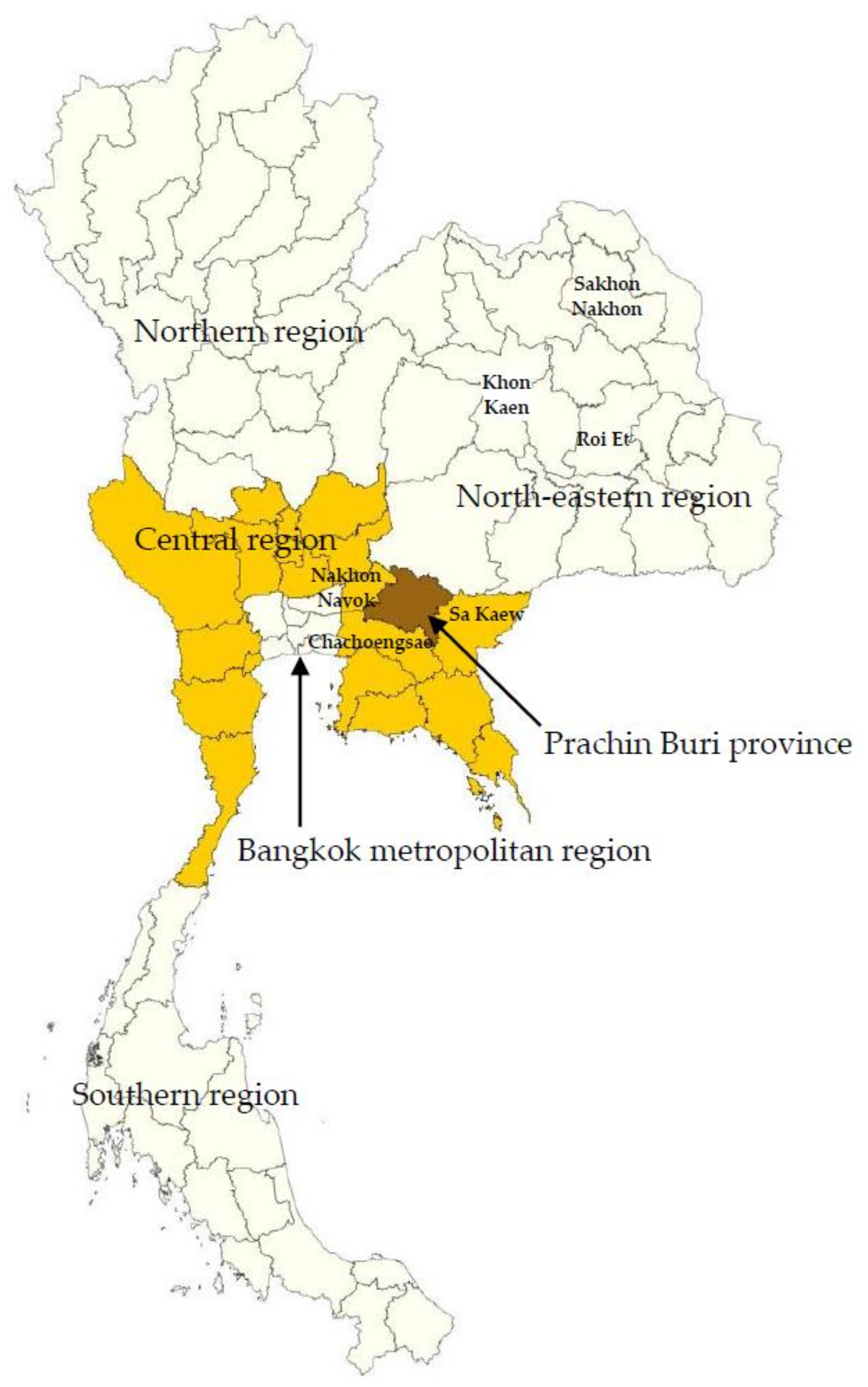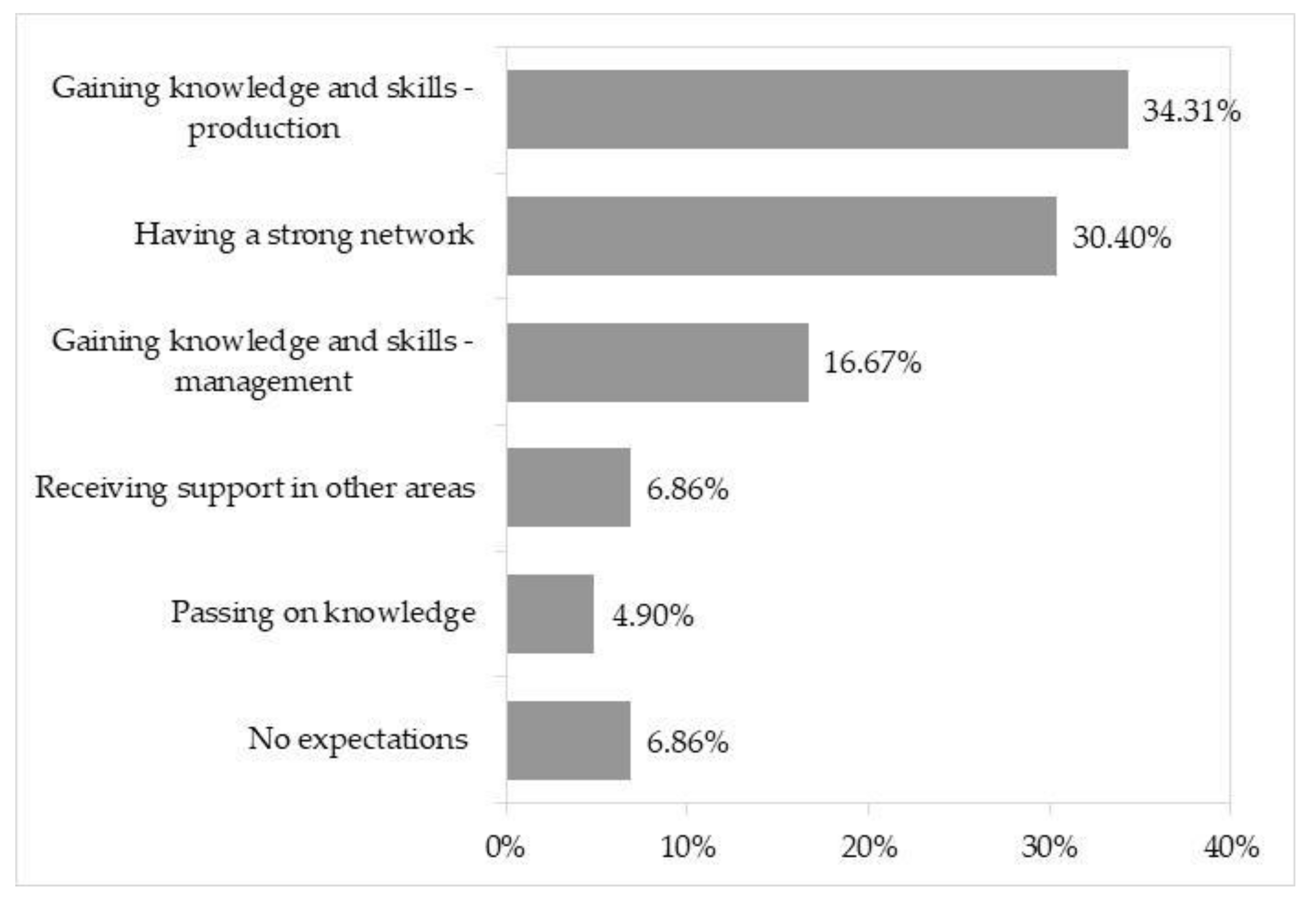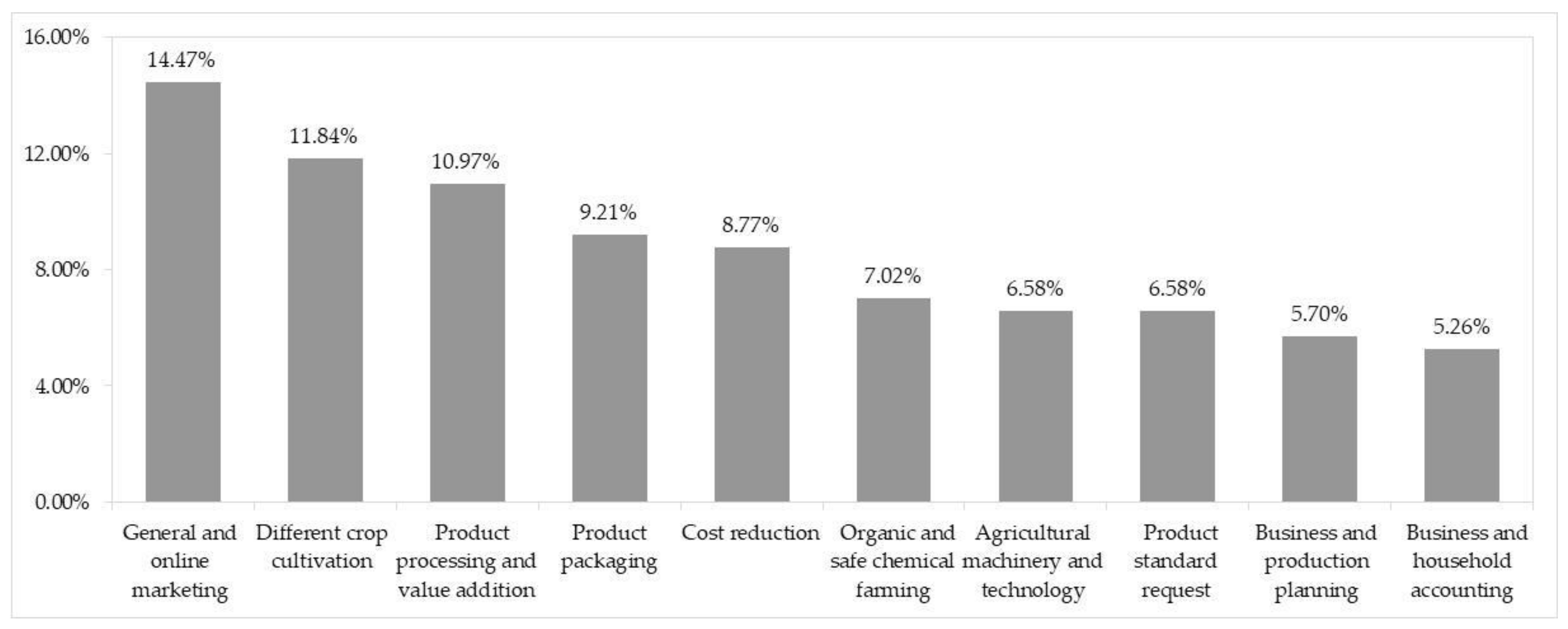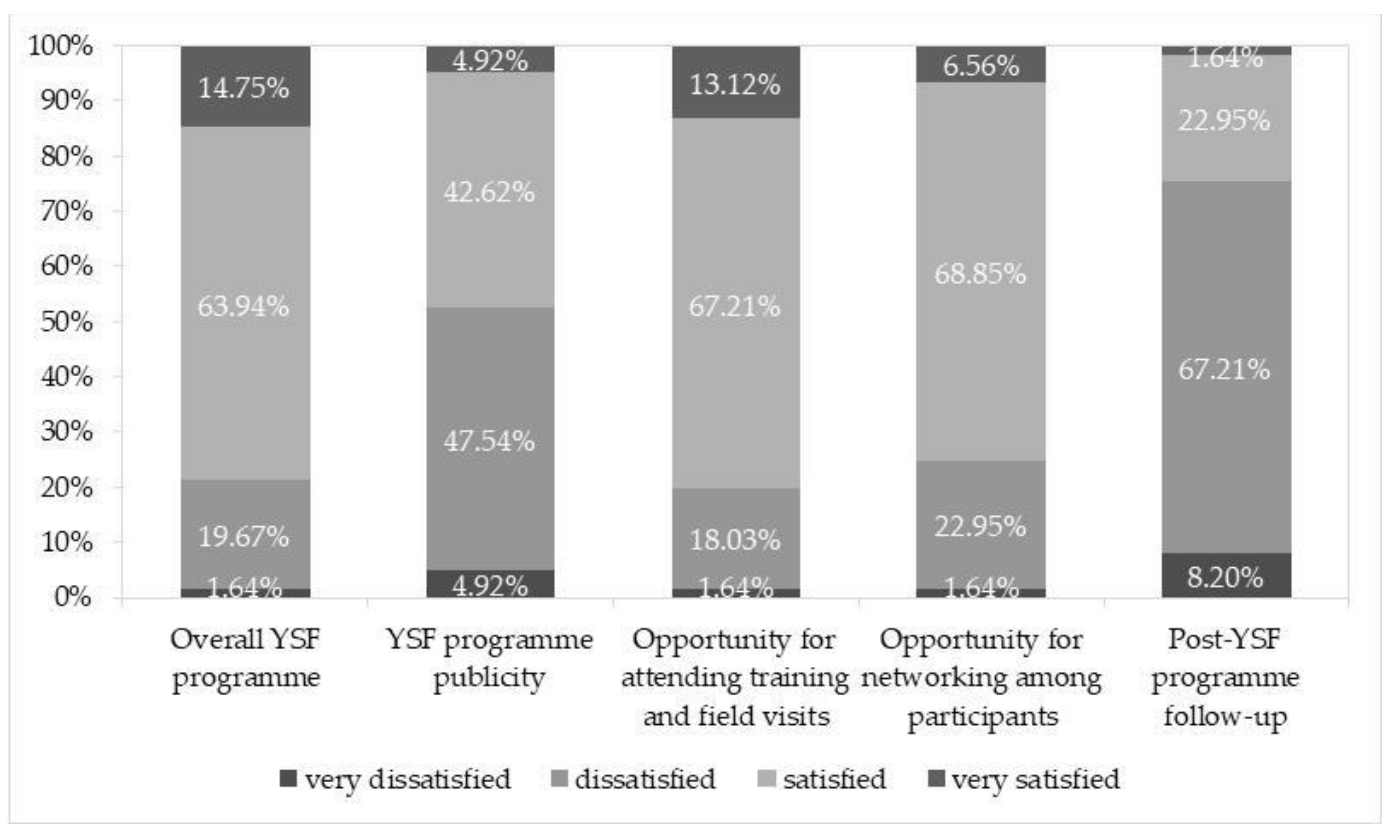Getting Young People to Farm: How Effective Is Thailand’s Young Smart Farmer Programme?
Abstract
1. Introduction
2. The Young Smart Farmer Programme Background and Evaluation Framework
2.1. The Young Smart Farmer Programme
- (1)
- to increase the number of young farmers by motivating young people to continue, return to, or enter farming to replace older farmers;
- (2)
- to help young farmers to become agricultural leaders in their communities; and
- (3)
- to create collaborative networks among relevant stakeholders for the development of the agricultural sector of the country.
- (1)
- to make young farmers become financially independent with their own farming businesses and
- (2)
- to enhance the adoption of innovative farming methods by young farmers.
2.2. Evaluation Framework
3. Data and Methods
3.1. Research Area
3.2. Sampling, Data Collection and Questionnaire
3.3. Data Analysis
- (1)
- estimation of the binary logistics regression model and propensity scores,
- (2)
- examination of common support between the distribution of propensity score estimated for participants and non-participants,
- (3)
- matching non-participants with participants based on their similar estimated propensity scores,
- (4)
- estimation of the programme’s impact, and
- (5)
- examination of matching quality and influence of unobserved factors on the estimated programme impact (Table S1 in Supplementary Materials).
4. Results
4.1. Sample Description
4.2. Inputs, Activities, and Outputs of the Young Smart Farmer Programme
4.3. Satisfaction with the Young Smart Farmer Programme
4.4. Impact Evaluation of the Young Smart Farmer Programme on Participants’ Economic Viability
4.4.1. Binary Logistic Regression Model and Propensity Score Estimation
4.4.2. Matching and Estimating the Young Smart Farmer Programme Effect on Participants’ Net Farm Income and Adoption of Innovative Farming Methods
5. Discussion
5.1. The Young Smart Farmer Programme Participation and Satisfaction
5.2. Impact of the Young Smart Farmer Programme
5.3. Policy Recommendations
5.4. Study Limitations
6. Conclusions
Supplementary Materials
Author Contributions
Funding
Institutional Review Board Statement
Informed Consent Statement
Data Availability Statement
Acknowledgments
Conflicts of Interest
References
- Agricultural Development Plan during the 11th National Economic and Social Development Plan (B.E. 2555–2559). Available online: https://planning.dld.go.th/th/images/stories/section-5/2556/policy_03.pdf (accessed on 22 April 2020). (In Thai).
- Nordin, M.; Lovén, I. Is the Setting Up Aid Mitigating the Generational Renewal Problem in Farming? Eur. Rev. Agric. Econ. 2020, 47, 1697–1715. [Google Scholar] [CrossRef]
- The 2008 Agriculture Intercensal Survey-Whole Kingdom; National Statistical Office: Bangkok, Thailand, 2010. Available online: http://statbbi.nso.go.th/nso/nso_center/project/table/files/S-sk/2551/000/00_S-sk_2551_000_160000_01601.xls (accessed on 22 April 2020).
- The 2018 Agriculture Intercensal Survey-Whole Kingdom; National Statistical Office: Bangkok, Thailand, 2020. Available online: http://www.nso.go.th/sites/2014en/Pages/survey/Economics/Agriculture/Agriculture-Intercensal-Survey.aspx (accessed on 22 April 2020).
- Attavanich, W. Did the Thai Rice-pledging Programme Improve the Economic Performance and Viability of Rice Farming? Appl. Econ. 2016, 48, 2253–2265. [Google Scholar] [CrossRef]
- Watanabe, M.; Jinji, N.; Kurihara, M. Is the Development of the Agro-processing Industry Pro-poor?: The Case of Thailand. J. Asian Econ. 2009, 20, 443–455. [Google Scholar] [CrossRef]
- Phiboon, K.; Cochetel, C.; Faysse, N. Support Programmes and the Diversity of Young Farmers in Thailand: A Good Match? Outlook Agric. 2019, 48, 300–308. [Google Scholar] [CrossRef]
- Rittirong, J.; Prasartkul, P.; Rindfuss, R.R. From whom do Older Persons prefer Support? The Case of Rural Thailand. J. Aging Stud. 2014, 31, 171–181. [Google Scholar] [CrossRef] [PubMed]
- May, D.; Arancibia, S.; Behrendt, K.; Adams, J. Preventing Young Farmers from Leaving the Farm: Investigating the Effectiveness of the Young Farmer Payment Using a Behavioural Approach. Land Use Policy 2019, 82, 317–327. [Google Scholar] [CrossRef]
- Rigg, J.; Phongsiri, M.; Promphakping, B.; Salamanca, A.; Sripun, M. Who will tend the Farm? Interrogating the Ageing Asian farmer. J. Peasant Stud. 2020, 47, 306–325. [Google Scholar] [CrossRef]
- White, B. Agriculture and the Generation Problem: Rural Youth, Employment and the Future of Farming. IDS Bull. 2012, 43, 9–19. [Google Scholar] [CrossRef]
- Young, A. Inequality, the Urban-rural Gap, and Migration. Q. J. Econ. 2013, 128, 1727–1785. [Google Scholar] [CrossRef]
- The 2019 Migration Survey. Available online: www.nso.go.th/sites/2014en/Survey/social/domographic/migration/2019/2_2019.rar (accessed on 17 June 2020). (In Thai)
- The Labor Force Survey: Whole Kingdom: Quarter 4: October–December 2019. Available online: http://www.nso.go.th/sites/2014en/Survey/social/labour/LaborForce/2019/Full%20Report_Q4_2019.pdf (accessed on 17 June 2020).
- World Food and Agriculture—Statistical Pocketbook 2019. Available online: http://www.fao.org/3/ca6463en/ca6463en.pdf (accessed on 23 April 2020).
- Morais, M.; Binotto, E.; Borges, J.A.R. Identifying beliefs underlying successors’ intention to take over the farm. Land Use Policy 2017, 68, 48–58. [Google Scholar] [CrossRef]
- Faysse, N.; Phiboon, K.; Filloux, T. Public Policy to Support Young Farmers in Thailand. Outlook Agric. 2019, 48, 292–299. [Google Scholar] [CrossRef]
- Maïga, W.H.E.; Porgo, M.; Zahonogo, P.; Amegnaglo, C.J.; Coulibaly, D.A.; Flynn, J.; Seogo, W.; Traoré, S.; Kelly, J.A.; Chimwaza, G. A systematic review of employment outcomes from youth skills training programmes in agriculture in low-and middle-income countries. Nat. Food 2020, 1, 605–619. [Google Scholar] [CrossRef]
- Nakano, Y.; Tsusaka, T.W.; Aida, T.; Pede, V.O. Is Farmer-to-farmer Extension Effective? The Impact of Training on Technology Adoption and Rice Farming Productivity in Tanzania. World Dev. 2018, 105, 336–351. [Google Scholar] [CrossRef]
- Salvago, M.R. Enhanced Entry of Young Generation into Agriculture: A Case Study in Prachinburi, Thailand. Master thesis, Asian Institute of Technology, Pathum Thani, Thailand, October 2018. [Google Scholar]
- Tripp, R.; Wijeratne, M.; Piyadasa, V.H. What should we expect from farmer field schools? A Sri Lanka case study. World Dev. 2005, 33, 1705–1720. [Google Scholar] [CrossRef]
- Van Driessche, P.A. Capacity building towards agricultural sustainability in the Maldives: Does the voice of the Maldivian farmer need to be amplified in planning agricultural interventions? Int. J. Agric. Sustain. 2020, 18, 537–553. [Google Scholar] [CrossRef]
- Zollet, S.; Maharjan, K.L. Overcoming the Barriers to Entry of Newcomer Sustainable Farmers: Insights from the Emergence of Organic Clusters in Japan. Sustainability 2021, 13, 866. [Google Scholar] [CrossRef]
- Santiago, A.; Roxas, F. Reviving farming interest in the Philippines through agricultural entrepreneurship education. J. Agric. Food Syst. Community Dev. 2015, 5, 15–27. [Google Scholar] [CrossRef]
- Wordofa, M.G.; Sassi, M. Impact of Farmers’ Training Centres on Household Income: Evidence from Propensity Score Matching in Eastern Ethiopia. Soc. Sci. 2018, 7, 4. [Google Scholar] [CrossRef]
- Wu, B.; Zhang, L. Farmer innovation diffusion via network building: A case of winter greenhouse diffusion in China. Agric. Hum. Values 2013, 30, 641–651. [Google Scholar] [CrossRef]
- Farmer Development Division. Report on the Young Smart Farmer Development; Department of Agricultural Extension: Bangkok, Thailand, 2018. (In Thai) [Google Scholar]
- Farmer Development Division. Report on the Young Smart Farmer Development; Department of Agricultural Extension: Bangkok, Thailand, 2019. (In Thai) [Google Scholar]
- Gertler, P.J.; Martinez, S.; Premand, P.; Rawlings, L.B.; Vermeersch, C.M. Impact Evaluation in Practice, 2nd ed.; International Bank for Reconstruction and Development/The World Bank: Washington, DC, USA, 2016. [Google Scholar]
- Yazdanpanah, M.; Feyzabad, F.R. Investigating Iranian Farmers’ Satisfaction with Agricultural Extension Programs Using the American Customer Satisfaction Index. J. Agric. Food Inf. 2017, 18, 123–135. [Google Scholar] [CrossRef]
- Elias, A.; Nohmi, M.; Yasunobu, K.; Ishida, A. Farmers’ Satisfaction with Agricultural Extension Service and Its Influencing Factors: A Case Study in North West Ethiopia. J. Agric. Sci. Technol. 2015, 18, 39–53. [Google Scholar]
- Buehren, N.; Goldstein, M.; Molina, E.; Vaillant, J. The Impact of Strengthening Agricultural Extension Services on Women Farmers: Evidence from Ethiopia. Agric. Econ. 2019, 50, 407–419. [Google Scholar] [CrossRef]
- Prachin Buri Provincial Development Plan B.E. 2561-2565 (Revised Version 2563). Available online: http://www.prachinburi.go.th/yut-prachin/plan61-65.rar (accessed on 6 May 2020). (In Thai).
- Gross Regional and Provincial Product: Chain Volume Measure: 2018 Edition. Available online: https://www.nesdc.go.th/ewt_dl_link.php?nid=5628&filename=gross_regional (accessed on 6 May 2020).
- Provincial Statistic Report: Demography, Population and Housing Statistics. Available online: http://pchburi.old.nso.go.th/nso/project/search/index.jsp?province_id=32&fid=3&pro_code=O-src-01&pro_year=2561&data_type=3 (accessed on 6 May 2020).
- Prachin Buri Provincial Agricultural Extension Office. List of Participants of the Young Smart Farmer Programme in the Prachin Buri Province; Department of Agricultural Extension: Bangkok, Thailand, 2018. (In Thai) [Google Scholar]
- Farmer Development Division. List of Participants of the Young Smart Farmer Programme in the Prachin Buri Province; Department of Agricultural Extension: Bangkok, Thailand, 2018. (In Thai) [Google Scholar]
- Olmos, A.; Govindasamy, P. Propensity Scores: A Practical Introduction Using R. J. MultiDiscip. Eval. 2015, 11, 68–88. [Google Scholar]
- Leite, W. Practical Propensity Score Methods Using R.; SAGE Publications, Inc.: Thousand Oaks, CA, USA, 2017. [Google Scholar]
- Ministry of Agriculture and Cooperatives’ Budget in Brief, Fiscal Year 2017. Available online: http://www.oae.go.th/assets/portals/1/files/ebook/Budjet2561.pdf (accessed on 3 March 2021). (In Thai).
- Pratiwi, A.; Suzuki, A. Effects of Farmers’ Social Networks on Knowledge Acquisition: Lessons from Agricultural Training in Rural Indonesia. J. Econ. Struct. 2017, 6, 8. [Google Scholar] [CrossRef]
- Jones, L.E.; Diekmann, F.; Batte, M.T. Staying in Touch through Extension: An Analysis of Farmers’ Use of Alternative Extension Information Products. J. Agric. Appl. Econ. 2010, 42, 229–246. [Google Scholar] [CrossRef][Green Version]
- The Long Way to Farming: The Plans of Agriculture Students in Thailand. Available online: http://deltasoutheastasia-doubt.com/wp-content/uploads/UploadedDocuments/FillouxTheLongWayToFarmingPlansOfStudentsInAgriculture.pdf (accessed on 9 February 2021).
- Lachaud, M.A.; Bravo-Ureta, B.E.; Fiala, N.; Gonzalez, S.P. The Impact of Agri-business Skills Training in Zimbabwe: An Evaluation of the Training for Rural Economic Empowerment (TREE) Programme. J. Dev. Eff. 2018, 10, 373–391. [Google Scholar] [CrossRef]
- Läpple, D.; Hennessy, T.; Newman, C. Quantifying the Economic Return to Participatory Extension Programmes in Ireland: An Endogenous Switching Regression Analysis. J. Agric. Econ. 2013, 64, 467–482. [Google Scholar] [CrossRef]
- Calo, A. How Knowledge Deficit Interventions Fail to Resolve Beginning Farmer Challenges. Agric. Hum. Values 2018, 35, 367–381. [Google Scholar] [CrossRef]
- Lamontagne-Godwin, J.; Williams, F.; Bandara, W.M.P.T.; Appiah-Kubi, Z. Quality of Extension Advice: A Gendered Case Study from Ghana and Sri Lanka. J. Agric. Educ. Ext. 2017, 23, 7–22. [Google Scholar] [CrossRef]
- Maffioli, A.; Ubfal, D.; Vazquez-Bare, G.; Cerdan-Infantes, P. Improving technology adoption in agriculture through extension services: Evidence from Uruguay. J. Dev. Eff. 2013, 5, 64–81. [Google Scholar] [CrossRef]
- Mariano, M.J.; Villano, R.; Fleming, E. Factors Influencing Farmers’ Adoption of Modern Rice Technologies and Good Management Practices in the Philippines. Agric. Syst. 2012, 110, 41–53. [Google Scholar] [CrossRef]
- Timprasert, S.; Datta, A.; Ranamukhaarachchi, S.L. Factors Determining Adoption of Integrated Pest Management by Vegetable Growers in Nakhon Ratchasima Province, Thailand. Crop Prot. 2014, 62, 32–39. [Google Scholar] [CrossRef]
- Impact Evaluation in the ILO: Stock-Taking of Current Practice. Available online: https://www.ilo.org/wcmsp5/groups/public/---ed_mas/---eval/documents/publication/wcms_315256.pdf (accessed on 26 February 2021).
- Somkaun, N.; Chumnanmak, R.; Narongchai, W.; Suppatkul, P. The Transformation from Farmer to Entrepreneur in Khon Kaen Province, Thailand. J. Mekong Soc. 2019, 15, 95–120. [Google Scholar]





| Variable | Coding/Definition | Total Sample (n = 176) | Non-Participants (n = 115; 65%) | Participants (n = 61; 35%) | Difference | |||
|---|---|---|---|---|---|---|---|---|
| Mean | SD | Mean | SD | Mean | SD | |||
| Outcome | ||||||||
| Net income | Net farm income per rai in baht | 31,152 | 111,541 | 27,979 | 73,215 | 37,134 | 161,391 | t = −0.52 |
| Innovative method | 1 = adopts innovative farming methods other than common machineries and chemicals, 0 = none | 0.83 | 0.38 | 0.78 | 0.41 | 0.92 | 0.28 | = 5.17 ** |
| Demographic and family characteristics | ||||||||
| Gender | 1 = male, 0 = female | 0.54 | 0.50 | 0.54 | 0.50 | 0.54 | 0.50 | = 0.001 |
| Age | Age of the farmer | 40.40 | 5.47 | 41.31 | 4.75 | 38.67 | 6.30 | t = 2.87 *** |
| Education | 1 = completes education above year 9, 0 = none | 0.62 | 0.49 | 0.46 | 0.50 | 0.92 | 0.28 | = 35.33 *** |
| Child | 1 = has a dependent child, 0 = none | 0.63 | 0.48 | 0.64 | 0.48 | 0.62 | 0.49 | = 0.02 |
| Farming characteristics | ||||||||
| Size | Total area of farming in rai | 30.75 | 40.29 | 30.91 | 33.50 | 30.46 | 51.03 | t = 0.07 |
| Tenure | 1 = owns most of farmland, 0 = none | 0.55 | 0.50 | 0.48 | 0.50 | 0.69 | 0.47 | = 7.12 *** |
| Activity | 1 = only produces rice, 0 = none | 0.27 | 0.45 | 0.28 | 0.45 | 0.26 | 0.44 | = 0.05 |
| Experience | Number of years of own farming | 11.61 | 8.17 | 13.91 | 8.22 | 7.27 | 6.08 | t = 6.09 *** |
| Off-farm income | 1 = off-farm income, 0 = none | 0.75 | 0.43 | 0.79 | 0.41 | 0.67 | 0.47 | = 3.02 * |
| Other support | 1 = receives other farming support from the government, 0 = none | 0.93 | 0.26 | 0.93 | 0.26 | 0.92 | 0.28 | = 0.09 |
| Farming problem characteristics | ||||||||
| Marketing problem | 1 = faces falling product prices, rising costs, and insufficient funds; 0 = none | 0.51 | 0.50 | 0.64 | 0.48 | 0.25 | 0.43 | = 25.20 *** |
| Pest problem | 1 = faces outbreak of plant diseases, weeds, insect, and animal pests; 0 = none | 0.30 | 0.46 | 0.30 | 0.46 | 0.28 | 0.45 | = 0.13 |
| Weather problem | 1 = faces irregular weather, 0 = none | 0.39 | 0.49 | 0.43 | 0.50 | 0.33 | 0.47 | = 1.61 |
| Soil problem | 1 = faces poor quality soil, 0 = none | 0.06 | 0.24 | 0.05 | 0.22 | 0.08 | 0.28 | = 0.60 |
| Farm location characteristics | ||||||||
| Distance1 | Distance from the farmer’s farm to district agricultural extension office in km | 14.21 | 8.52 | 13.82 | 8.85 | 14.93 | 7.86 | t = −0.82 |
| Distance2 | Distance from the farmer’s farm to provincial agricultural extension office in km | 39.55 | 20.67 | 40.46 | 20.72 | 37.83 | 20.62 | t = 0.80 |
| Variable | Participation (n = 176) | ||
|---|---|---|---|
| Coef. | SE | OR | |
| Gender | −0.29 | 0.46 | 0.75 |
| Age | −0.001 | 0.04 | 1.00 |
| Education | 2.26 *** | 0.63 | 9.60 |
| Child | −0.005 | 0.44 | 1.00 |
| Size | 0.01 ** | 0.01 | 1.01 |
| Tenure | 0.005 | 0.48 | 1.01 |
| Activity | 0.84 | 0.60 | 2.31 |
| Experience | −0.09 ** | 0.04 | 0.91 |
| Off-farm income | −0.27 | 0.50 | 0.77 |
| Other support | −0.38 | 0.81 | 0.69 |
| Marketing problem | −2.31 *** | 0.59 | 0.10 |
| Pest problem | −0.80 | 0.51 | 0.45 |
| Weather problem | −0.92 * | 0.51 | 0.40 |
| Soil problem | 0.56 | 0.96 | 1.75 |
| Distance1 | 0.09 ** | 0.04 | 1.10 |
| Distance2 | −0.02 | 0.02 | 0.98 |
| Hosmer and Lemeshow goodness of fit test (Chi-squared) | 8.99 | ||
| p-value | 0.34 | ||
| McFadden’s R-squared | 0.37 | ||
| Variable | Matching Algorithm | |||||||
|---|---|---|---|---|---|---|---|---|
| NNM | NNMR 2:1 | NNMR 0.20 | NNMR 0.25 | GM | OM | FM | SUB | |
| Net farm income | ||||||||
| Participation | −7526 (23,643) 1 | −7596 (31,097) 1 | −4703 (33,204) 1 | −4589 (32,724) 1 | −7716 (23,638) 1 | −7526 (23,643) 1 | −7188 (32,601) 1 | −8818 (29,023) 1 |
| Innovative farming methods | ||||||||
| Participation | 0.79 (2.20) 2 | 0.53 (1.69) 2 | 0.37 (1.45) 2 | 0.37 (1.45) 2 | 0.90 (2.46) 2 | 0.79 (2.20) 2 | 0.54 (1.72) 2 | 0.60 (1.81) 2 |
| Matched samples | 122 | 97 | 85 | 86 | 122 | 122 | 113 | 113 |
| Non-participants | 61 | 36 | 25 | 25 | 61 | 61 | 52 | 52 |
| Participants | 61 | 61 | 60 | 61 | 61 | 61 | 61 | 61 |
Publisher’s Note: MDPI stays neutral with regard to jurisdictional claims in published maps and institutional affiliations. |
© 2021 by the authors. Licensee MDPI, Basel, Switzerland. This article is an open access article distributed under the terms and conditions of the Creative Commons Attribution (CC BY) license (https://creativecommons.org/licenses/by/4.0/).
Share and Cite
Jansuwan, P.; Zander, K.K. Getting Young People to Farm: How Effective Is Thailand’s Young Smart Farmer Programme? Sustainability 2021, 13, 11611. https://doi.org/10.3390/su132111611
Jansuwan P, Zander KK. Getting Young People to Farm: How Effective Is Thailand’s Young Smart Farmer Programme? Sustainability. 2021; 13(21):11611. https://doi.org/10.3390/su132111611
Chicago/Turabian StyleJansuwan, Para, and Kerstin K. Zander. 2021. "Getting Young People to Farm: How Effective Is Thailand’s Young Smart Farmer Programme?" Sustainability 13, no. 21: 11611. https://doi.org/10.3390/su132111611
APA StyleJansuwan, P., & Zander, K. K. (2021). Getting Young People to Farm: How Effective Is Thailand’s Young Smart Farmer Programme? Sustainability, 13(21), 11611. https://doi.org/10.3390/su132111611







